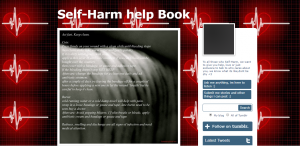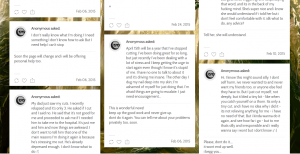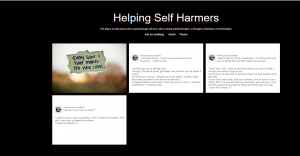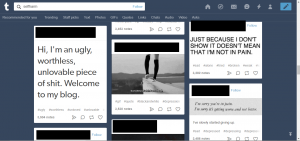The Truth-Speakers: An Analysis of Tumblr’s Self-harm Communities
Nayantara Nayar
This paper occasionally contains strong language and disturbing visuals.
Abstract
Tumblr is a short-blogging platform launched in 2007 by David Karp. It allows people to blog but in a way that is more multi-media efficient than blog websites like WordPress or Blogspot. This paper analyses Tumblr as a site where certain processes of truth-telling take place within existing self-harm communities. The author’s analysis of Tumblr is predicated upon 1) the problematic ways in which self-harm is pathologised (this extends to institutional understandings of online self-harm communities) and 2) a set of lectures Foucault delivered in Berkley in the 1980s where he discussed the Greek idea of parrhêsia or truth-telling and how it resulted in constructions of the subjective self. The study is based on the interactions between members of Tumblr who identify as being part of the self-harm community: That includes people who practice self-harm (i.e. cutting, burning etc), people who encourage it and people who might, but do not only have to be, ex-harmers who try to provide support and advice about how to stop self-harming. Foucault suggested that parrhêsia was experienced by the Greeks when “your own life is exposed (and) you are taking up a specific relationship to yourself: you risk death to tell the truth instead of reposing in the security of a life where the truth goes unspoken…” (Foucault, 1984) but he thought that such a relationship to truth no longer existed in modern societies. This paper suggests that through the digital space of Tumblr, conditions for the parrhêsiastic game are re-established and complex webs of selfhood are created. Further the author argues that looking at the practice of self-harm through such a lens would better enable attempts to guide harmers out of self-destructive behaviours.
Keywords: Blogging, Self-Harm.
Tumblr: An Introduction
Tumblr is a short-blogging platform launched in 2007 by David Karp that allows users to create blogs that are multi-media efficient, streamlined and easy to use. Users have one or many unique Tumblr web pages from where they can like, create and reblog content and, follow the activities of other Tumblr blogs. These blogs could be those of friends, celebrities, companies, artists etc. Users are allowed to share photographs, videos, audio, and internet links, create GIFs and conduct live chats. Tumblr blogs have privacy settings whereby users can allow and block followers. What makes Tumblr different from other social networking sites like Facebook, Twitter or Pintrest, and from other blogging platforms like WordPress or Blogspot is essentially design. Tumblr combines easy access to multi-media options and a streamlined homepage called a ‘dashboard’ that uses vertical lines to track comments and likes. Additionally word count and image sizes have high upper limits, users can queue their posts to be shared at specific dates and times, and posts contain tags that enable users to decide what areas their content will be contributing to/targeted towards.
In 2013 Yahoo! bought Tumblr for a little more than a billion dollars. As of 2017 there are approximately 357 million blogs on Tumblr. The nature of these blogs and the kind of content they generate are varied, both in terms of subject matter and form. For example one kind of common Tumblr posts are GIFS (a series of moving images that play on loop). The GIFS might be about celebrities, scenes from movies or television shows, from videos off YouTube etc. Content on Tumblr might also be in the form of memes, written posts, audio clips, vines and videos. Some users see Tumblr as a simple blogging platform where they can share their writing and practice journaling, others use it to create and share art, music, poetry, and design ideas1. The ability to follow other blogs and reblog content means that creating original content is not necessary- users could just follow, like and reblog, thus curating an online identity. This online identity could possibly have cultural currency, though the nature and value of that currency varies in terms of the areas users are interested in: for example bloggers who create an endless stream of content around popular television shows, movies and books hold a certain universal appeal and communities are often created around what is reblogged. At the same time, certain companies also have tumblogs- the New Yorker, Moth, McDonalds- use Tumblr to promote their brands. While they do not share the more obvious characteristics of what is classically understood as a community (a shared living space), communities on Tumblr do share cultural and digital space. In this way Tumblr is an online space that has a lot of variation in form, content and user base. The innovative design makes it possible for people to engage with their varied interests and with other people in ways that suit them personally while at the same time allowing for privacy if required.
Self-Harm
On Tumblr apart from the memes, GIFs and discussion threads about books, fashion or upcoming movies, there is a very active self-harm community. Self-harm or non-suicidal self-injury (NSSI) refers to a large variety of body mutilation practises including pinching, scratching, cutting, burning, anorexia, bulimia and pulling hair out by the roots.
Fig 1. A Tumblr search page when the words self-harm are typed in

A study conducted by ACT for Youth Centre, a collaboration of the Cornell University, University of Rochester, and New York State Center for School Safety found that harmers cited the need to ‘calm down’ as their primary reason for doing what they do. The same study also found that individuals turned to self-harm when they were emotionally distressed or ‘overwrought’:
People who self-injure often have high sensitivity to emotion and difficulty handling negative feelings. Although the practice may dispel strong feelings in the short term, over time individuals with a history of self-injury are likely to experience intense shame or a sense of lack of control (Whitlock, Muehlenkamp, et al. 2009: 3).
The same study also points out that NSSI is also used to break through numbness, as ‘self-control, punishment, or distraction’, as a pick-me-up in terms of mood and energy, for attention or to feel a sense of belonging within a group. However, Chandler, Myers and Platt, in their paper The Construction of Self-Injury in the Clinical Literature: A Sociological Exploration, suggest that the ways in which self-harm is studied and researched are very problematic. They argue that the very term ‘self-harm’ is the result of a kind of unwillingness on the part of researchers to ‘ascribe motives’ to the harmers. They go on to say,
…their (the terms self-harm, NSSI) usefulness is limited by variations in usage. Self-harm and deliberate self-harm refer to a range of behaviours, including self-injury, but also encompass self-poisoning/overdose and sometimes also eating disorders, substance abuse, reckless behaviour, and other activities which either do or may result in harm to the self (2011: 99).
Chandler, Myers and Platt use this as a starting point to argue that research around ‘self-injury’ had often been impatient (causation without correlation, such as “all people who self-injure are usually survivors of some kind of childhood abuse”), tending towards gross generalizations (such as the still often un-criticised assumption that “women might cut or injure themselves because they are women”) and are unwilling to consider the issue holistically (arguments around psychiatric and psychological classifications of behaviour such as ‘impulsivity’). The authors also suggest that regarding self-harm pathologically ignores the structural factors at play. These shortcomings are particularly linked to the fact that much self-harm is the result of poor self-conception. A study published in the Journal of Adolescence discovered that adolescents engaging in self-harm “frequently described themselves as less intelligent, emotionally stable, and physically attractive than” students who did not engage in similar behaviours (Claes, Houben et al., 2010: 777). There is however a failure to engage with this as a motivating factor of self-harm. For example in 2012, Tumblr took action against blogs that encouraged self-harm behaviour by revising its content policy and offering PSAs when certain keywords such as ‘self-harm’ or ‘ano’(anorexia) were typed in. Criticism against Tumblr for allowing content that promotes self-harm has been strong, however in keeping with what Chandler et al. write about the pathologisation of self-harm there is a real inability on the part of health institutions, governments and parents to understand how young adults engage with self-harm online. Engaging with the posts would show that behaviours such as cutting and anorexia are obviously linked to low self-conceptions that are a result of high stress school and peer environments, which are in turn very much a reflection of contemporary, goal-oriented societies where success is constantly quantified. In corollary the policies Tumblr put in place had some effect of websites that were pro-harm, but the same policies also censored both bloggers who were trying to help, and bloggers who were using their tumblogs as a place to express grief, rage, and depression, and/or as a place where they could ask for help.
Methodology and Positioning
This paper offers a reading of self-harm that veers away from ‘mainstream’ understandings by disrupting the discourse around self-harm and describing the ways in which members of the community on Tumblr engage with the issue. I was able to look at blogs and study bloggers as they posted content about their experiences with self-harm- in this way I was certainly ‘in the field’ however I have never officially interviewed or participated in their community, choosing instead to be an observer. The pitfalls of the observer-researcher are all too obvious to me, but I have a more pressing disadvantage: the blogs being anonymous, I have no access to information about the community as a whole. I do not know average ages, nationalities, gender or sexual preferences. With regards to self-harm, research and literature around the area suggests that self-harm is seen more in adolescent groups with individuals aged between 11 and 162. While independent research organisations tell us that on average a little over thirty percent of Tumblr users are located in the United States of America3 (Statista 2017) Tumblr claims to have a worldwide user base of approximately 357 million blogs running as of 2017. The number of blogs that post about self-harm, as of 2012, was thought to be approximately 200,0004 and there was a mixture of languages seen. Therefore there is reason to believe that this paper applies quite widely within the community it concerns itself with. The paper lies somewhere between ethnography and qualitative analysis of the content, because while I engage with the field it is the posts themselves that have been the main focus of my study. I have tried to outline some basic patterns of posting and sub-groups within the community by reading through self-harm tags. From there I have tried to see how bloggers link questions of self-hood to self-harm.
In Invisible Girls: Gender, Identity and Performativity in Self-Harm Tumblrs, Jessie Hunt argues that the paradigm within which self-harm is studied lacks nuance. Hunt bases her paper on interactions she had with members of the self-harm community on Tumblr, all of whom turned out to be women. Using these women and their activities as a base, Hunt argues that self-harm blogs might be seen as acts of resistance against stereotypes about gender and sexuality and “the network of self-harm blogs on Tumblr can be understood as a kind of virtual safe space for young women” (Hunt nd: 1). Hunt’s arguments are problematic, and she is working with what is essentially a limited sample size, but she acknowledges this by saying “young women’s options for resistance are so slim on the ground that we take to the symbolic destruction of our corporeal bodies [to gain a sense of freedom]…” (ibid: 3). While the issue of what can be construed as resistance in such a situation is a complex one, the value of the research done by both Hunt and by Chandler, Myers and Platt is not whether or not they can offer ‘cures’ for self-harmers- and in keeping with that they do not suggest that self-harming is healthy behaviour, or that psychology and psychiatry are not capable of helping harmers- it is their decision to try to actively think about self-harm in different ways that is useful and interesting. They suggest that there is a need to look at the discourse around self-harmers and understand how clashes with systemic understandings of normality (whether in behaviour, body type, intelligence) lead to self-harm behaviours that are then seen by the subjects as part of some process of claiming certain kinds of subjective identities.
Theoretical Framework: Foucault and the Parrhêsiastic Game
To explore this idea further this paper turns to an ethical paradigm Foucault talked about in a series of lectures he delivered at Berkeley in the 1980s. Foucault concerned himself with the origin of the word ‘parrhêsia’- a word that he traces back to the Ancient Greeks. The word itself can be broken down into the root words ‘pan’ which means all and ‘rhema’ meaning utterance or speech. The word translates as ‘to say everything’. However, it is better understood if thought of as a kind of ‘free-spokeness’ (Foucault 1984). Foucault is concerned with tracing the evolution of this idea of truth-telling as a moral imperative, and with the ways in which it influences the construction of the subjective self. Foucault says, about his study,
My intention was not to deal with the problem of truth, but with the problem of the truth-teller, or of truth-telling as an activity …who is able to tell the truth, about what, with what consequences, and with what relations to power… (ibid)
The questions Foucault asked are particularly relevant to the question of self-harm bloggers and their presence on digital platforms such as Tumblr. The implications of self-harm for the harmer are also social: they are seen as ‘undesirables’ whose proper place is considered to be the margins of society. Foucault addresses this theme, exactly in his book Madness and Civilization: A History of Insanity in the Age of Reason when he suggests that what is understood by ‘madness’ and how it is treated are heavily influenced by the economy, polity and ideas of morality at a given time. Today modern psychiatric and psychological approaches to self-harm are continuations of practises of separation and confinement that Foucault describes as having begun towards the end of the eighteenth century. The argument that this paper makes does not look at self-harm bloggers through the framework of modern understandings of madness (or rather through the framework that describes the subjugation of certain behaviours into such a discourse), but through the frameworks of truth-telling.
According to Foucault in ancient Greek society four kinds of people were known to speak the truth: (i) the oracle or prophet who spoke the truth of a divine, supernatural being and this truth was beyond his/her control; (ii) the wise man who offered what only he knew, and offered it only when asked; (iii) the teacher who spoke of what was well-known and accepted in society and helped integrate their students; (iv) and the parrhêsiast, who spoke for himself, who was obliged to speak the truth (he cannot stay silent) and who was courageous as his truth often caused conflict. Parrhêsia then is the relationship between a speaker and what they say, where everything they are saying is understood to be their own opinion, but it is also known to be the truth: especially to the interlocutor (the person or people being spoken to). The speaker does this not by using rhetoric, but by speaking plainly and directly to the interlocutor. So then the parrhêsiast is someone who says everything they are thinking and in their speech there is a coincidence of belief and truth that becomes a kind of knowledge. There is then also a lack of doubt around the parrhêsiast’s speech, precisely because of their conviction. This does present a situation where truth-telling can be seen to have negative consequences where the truth speaker gives no consideration to what they are saying and thus their speech is actually an obstacle to contemplation5. This is why Foucault adds that for parrhêsia to take place an element of duty is necessary. Thus the speaker is either inclined to speak the truth to the interlocutor who is unaware he/she is in the wrong, or the speaker is inclined to admit some truth about their own misdeeds.
Finally a person is only a parrhêsiast if there is a risk involved in telling the truth. For example, in a situation between a jeweller and a rich client, the jeweller tells the client that a certain kind of stone does not suit the client. This is a situation where the jeweller is a parrhêsiast because he risks offending the client and losing his/her patronage. However, while there is risk involved, parrhêsia is not merely exposing oneself to danger; instead it has the character of criticism. Parrhêsia requires that either the speaker talks critically of themselves to a person of a higher position (so they might punish the speaker for whatever action warranted the self-critique), or that the speaker criticizes the interlocutor herself/himself (where the interlocutor’s anger at being the subject of criticism results in some risk for the parrhêsiast).
When you accept the parrhêsiastic game in which your own life is exposed, you are taking up a specific relationship to yourself: you risk death to tell the truth instead of reposing in the security of a life where the truth goes unspoken. Of course, the threat of death comes from the Other, and thereby requires a relationship to himself: he prefers himself as a truth-teller rather than as a living being who is false to himself (Foucault, 1984).
Foucault’s study of parrhêsia was aimed at understanding the role of truth speakers as they exist in modern societies. For him, in modern societies the oracle-esque figure was replaced by the revolutionary, the wise man by the philosopher and the teacher by the scientist. The parrhêsiast, Foucault said, was missing except for when they, briefly, lived through these three other modalities of discourse. That is to say in the modern world where the “coincidence between belief and truth” occurs in “certain (mental) evidential experiences”, a Greek understanding of this same coincidence as only occurring “in a verbal activity” has no place. He aimed, instead, to “investigate how these four modalities are combined in different cultures, societies or civilisations, in different modes of discursivity” i.e. in the different regimes of truth found in different societies (ibid). However it might still be possible to look for purer instances of parrhêsia in the culture of confession and advice that forms part of the self-harm community on Tumblr.
Self-Harmers as Truth Speakers
On Tumblr the self-harm community is broadly made up of three different groups: People who practice self-harm, people who practice and encourage self-harm and people who might, but do not only have to be, ex-harmers who try to provide support and advice about how to stop self-harming. Within Tumblr the most common kinds of self-harm posts are about self-harm that either: a) creates an immediate impact such as cutting (cutting into the skin with a razor) and burning, or b) are extreme body regimes that have a visible impact over time (this would include anorexic and bulimic practices). Harmers who post about hurting themselves will write about it and/or post photographs of their bodies both before and after inflicting the harm.
Fig 2a&b. Images taken off self-harm blogs depicting cutting and anorexia


Fig2c. Support blog

An attempt to merely match characteristics between the theory and an actual cultural space might be thought of as at best a shallow exercise and at worst a pointless one. And yet it could be argued that shallowness and a lack of ‘point’ are exactly what make it worth doing. This paper is ultimately an exercise, not in ‘curing’ self-harmers, but in attempting to approach a set of difficult human behaviours from a perspective that might provide a better understanding of it and more empathy towards those engaging in it.
The actual objections that might arise from trying to link the ancient practise of parrhêsia to this modern one are: 1) there are more than two speakers in an online community, 2) that the anonymity of the digital world removes the problems of risk and 3) where do elements of duty or criticism enter the picture? First, according to Foucault parrhêsia does not require two players but a minimum of two players. Foucault provides an example of parrhêsia being practised amongst the people congregated at the Athenian agora. In the agora the speaker does not address every other citizen individually, but all his fellow citizens as the whole body politic or as one constituent being. In a similar way the users on Tumblr who are a part of the self-harm community- people that engage in self-harm behaviour, ex-harmers and people who simply wish to help and support self-harmers out of their situations- often talk to each other. Posts are created with specific tags like #selfharm #depression #cutting #anorexia etc, and the conversations around these posts (where reply posts are tagged similarly) function in a way that is similar to the Athenian agora. The amount of dialogue between the varied individuals within the community is extraordinary, as is the nature of that dialogue.
Fig3a&3b. A Support blog for harmers


Second, on the requirement of risk: Tumblr allows and even encourages the anonymity of its users. However, it could be argued that within the world of Tumblr, a blogger once identified as possessing certain interests, characteristics etc, gains a Tumblr reputation amongst his/her followers- the cultural capital mentioned before. For a member to then admit to practicing self-harm would mean that they are opening themselves to the (possible) rebuke, hate and criticism of their followers. Even in the case of the members who join specifically to use Tumblr as a platform to discuss their issues, and so only cultivate followers who also practise or practised self-harm, the assurance of it being a safe and accepting community is not a given. Community members often receive criticism for back-sliding, or hurting themselves in new ways. For the ex-harmers the risk is two-fold: by saying what they are there is a genuine risk that the people they are speaking to will take offence or object to the advice and either stop asking for help or respond by harming themselves further. There is also a serious risk of the ex-harmer backsliding when offering advice by reliving their memories. In an article on Buzzfeed titled Meet The Girl Behind One Of Tumblr’s Biggest Self-Harm Blogs, the 14 year old girl behind one of Tumblr’s most popular self-harm blogs ‘Depression and Disorders’ (no longer available) had this to say:
Nobody knows I have this blog. It helps me. Tumblr is powerful because it shows that you’re not alone. […] But it’s bad too because my Tumblr dashboard can be really triggering sometimes with all the posts from others. Like if you self-harm and you see pictures of cuts/scars it can be very triggering. (Sharrock 2013)
Third, we address the question of criticism and duty. Members who are currently practising self-harm write detailed posts about what they are feeling, why they think they are cutting themselves or why they are anorexic, how it feels to cut for the first time, the euphoria of it or the shame one feels afterwards.
Fig 4. Typical posts about self-harm

Ex-harmers or concerned members write back to people going through great difficulties, offering advice about how to deal with the depression or feelings of worthlessness that drove them to cut. There is thus obviously a speaker or set of speakers who talk directly about what he/she is feeling or thinking. The truth of their experience, be it practicing self-harmers or ex-harmers, is clear to all who read/see it. There is an absence of rhetoric- instead both harmers and ex-harmers depend on the truth of their experience to speak for itself. The element of criticism is very much present in this community: the criticism of oneself is obvious to see, but it also exists in the support and advice given by ex-harmers and concerned citizens. Take this post for example:
Fig 5a&5b. Post about Recovery


There is a need that drives these bloggers: a need to share the truth of their pain and of their destructive behaviours. For many of the members of the self-harm community, Tumblr is an indispensable space: their inability to confide in friends or family makes Tumblr the only space where they can speak their mind and also connect and talk with people going through similar problems. It is also a way for those who are recovering to be honest about the process and how far they have come, or whether they have backslid for some reason. This necessity is what partially separates this kind of truth-telling from what Foucault is talking about in ‘Truth and Power’.
Alison Ross in her paper, Why is ‘speaking the truth’ fearless? ‘Danger’ and ‘truth’ in Foucault’s discussion of parrhêsia speaks of Foucault’s dealings with truth in The History of Sexuality and says, “In La volonté de savoir the critique of the idea that there is an exclusionary relation between truth and power is carried out in terms of how the subject itself makes itself the site of knowledge and inquiry” (Ross, 2008: 64). She explains that according to Foucault, the ‘emancipatory’ nature of speaking the truth, specifically about one’s sexuality, is essentially a lie. This societal coaxing to tell the truth about oneself in fact plays right into what Foucault calls “biopower”, which joins up the interest of the disciplines in managing individuals to the interest of the modern state in the management of its population (ibid). Self-harm blogs on Tumblr escape this trap even if partially because the act of self-harm is necessarily a rejection of modern understandings of normality and productivity. I say ‘necessarily’ for the same reason that I say ‘partially’; because their rejection is often not conscious, even though that same rejection is a result of knowing that they, the self-harmers, will always be outsiders to such world-views. It is important to remember that the agency that Hunt allows her subjects is something that needs to be questioned and never taken for granted.
Conclusion
Almost at odds with his examination of truth in his other work, in his lectures on parrhêsia, Foucault talks of truth telling as having an ethical necessity or value: the parrhêsiast is in fact some kind of exemplar. But as Ross suggests, “What the exemplar chooses is primarily a relation to themselves, rather than the aspiration to shape practices” (Ross, 2008: 70). With regards to the self-harm bloggers this is doubly true: the bloggers who write or share images about their own experiences either as confession or as advice seek primarily not to persuade but to tell. Here, as in ancient Greece the coincidence between belief and truth lie in a verbal act- or in this case in a written one. Foucault sums this up well saying,
In parrhesia the speaker emphasises the fact that he is both the subject of the enunciation and the subject of the enunciandum — that he himself is the subject of the opinion to which he refers. The specific “speech activity” of the parrhesiastic enunciation thus takes the form: “I am the one who thinks this and that” (Foucault, 1984).
Looking at self-harm ‘bloggers’ as exemplars is useful in several ways. It allows for a discourse around the self-harmers that does not begin and end with understandings of their subjective identities that are purely pathologised. In an example Foucault gives, the advisor to a king has given his leader news that the king is not happy to hear, thereby fulfilling his parrhêsiastic duty. The king is now in the position to either accept this truth or punish his advisor for his speech. Foucault provides this example as a way to point out how parrhêsiastic speech leads to a situation that ideally extends beyond the speakers struggle with truth, even if this is not its primary purpose. The king, when deciding his reaction and the fate of his advisor is forced to consider on the one hand the nature of the subject being spoken and the impact of accepting it as truth, but he is also considering the nature of his advisor- is he a truth-speaker and does he, the king, have the ability to hear the truth, whatever it may be? Foucault explains that through the act of parrhêsia what is really being encouraged, what is being celebrated is the process of ‘knowing oneself’. The speaker is expressing themselves purely, with no deceit and thus what they say is what is true about themselves and what they think. This, Foucault believes, is what gave rise to the development of what could be called a “culture of self in which a whole set of practices of self are formulated, developed, worked out, and transmitted” (Foucault, 1984). Self-harmers design practices and rituals that they see as essential towards their own identity (either as defining it, or as removing aspects that they dislike). However through blogging about it, another culture of self is created where the identity of the speaker is still mediated by his/her self-harming practices, but it is more mediated by the fact that he/she is talking about it and telling the truth about it.
Nayantara Nayar is a Chevening FCO scholar and graduate of the University of Kent, where she completed her Masters in Contemporary Performance Practices. Prior to that she studied at the School of Media and Cultural Studies, Tata Institute of Social Sciences, Mumbai, and obtained a Masters in Media and Cultural Studies. Her current practice is based within storytelling which she uses to explore contemporary ideas about selfhood and culture. She is currently working on a practice-based research project around the role of memory in autobiographical performance practices.
References
AA Casilli, P Tubaro and F Pailler (2013) “Online Networks Of Eating-Disorder Websites: Why Censoring Pro-Ana Might Be a Bad Idea”. Perspectives in Public Health 133:94–95.
Bercovici, J. Tumblr: David Karp’s $800 Million Art Project. Available at: https://www.forbes.com/sites/jeffbercovici/2013/01/02/tumblr-david-karps-800-million-art-project/ [Accessed: 30 August 2017].
Chandler, A., Myers, F. and Platt, S. (2011) “The Construction of Self-Injury in the Clinical Literature: A Sociological Exploration”. Suicide and Life-Threatening Behavior 41:98–109.
Claes, L. et al. (2010) “Brief report: The Association between Non-Suicidal Self-Injury, Self-Concept and Acquaintance with Self-Injurious Peers in a Sample of Adolescents”. Journal of Adolescence. 33:775–778.
Eveleth, R. What Happened to ‘Self-Harm Blogs’ After Tumblr Banned Them? Available at: http://www.smithsonianmag.com/smart-news/what-happened-to-self-harm-blogs-after-tumblr-banned-them-15883320/ [Accessed: 6 September 2017].
Foucault, M. (1999) Discourse and Truth: The Problematization of Parrhesia. Digital Archive: Foucault.info.
Foucault, M. (2013) History of Madness. Routledge.
Foucault, M. (1983a) Parrhesia and the Crisis of Democratic Institutions. Discourse and Truth: the Problematization of Parrhesia. University of California, Berkeley. 1:01:22. Available at: http://ubumexico.centro.org.mx/sound/foucault_michel/parrhesia/Foucault-Michel_Discourse-and-Truth_1983_p831031.mp3.
Foucault, M. (1983b). Parrhesia in the Tragedies of Euripides. [Online]. Discourse and Truth: the Problematization of Parrhesia. University of California, Berkeley. 54:06. Available at: http://ubumexico.centro.org.mx/sound/foucault_michel/parrhesia/Foucault-Michel_Discourse-and-Truth_1983_p831024b.mp3.
Foucault, M. (1983c). Techniques of Parrhesia I. [MP3]. Discourse and Truth: the Problematization of Parrhesia. University of California, Berkeley. 46:35. Available at: http://ubumexico.centro.org.mx/sound/foucault_michel/parrhesia/Foucault-Michel_Discourse-and-Truth_1983_p831114a.mp3.
Foucault, M. (1983d). Techniques of Parrhesia II. [MP3]. Discourse and Truth: the Problematization of Parrhesia. University of California, Berkeley. 01:03:55. Available at: http://ubumexico.centro.org.mx/sound/foucault_michel/parrhesia/Foucault-Michel_Discourse-and-Truth_1983_p831114b.mp3.
Foucault, M. (1984). The Courage of Truth: The Government of Self and Others II. [MP3]. University of California, Berkeley. Available at: http://foucault.info/documents/foucault.courageoftruth.en.html.
Foucault, M. (1983e). The Practice of Parrhesia. [MP3]. Discourse and Truth: the Problematization of Parrhesia. University of California, Berkeley. 01:59:39. Available at: http://ubumexico.centro.org.mx/sound/foucault_michel/parrhesia/Foucault-Michel_Discourse-and-Truth_1983_p831024a.mp3.
Gabbatt, A. “Tumblr to Ban Self-Harm Blogs that Promote Anorexia and Bulimia”. The Guardian [Online]. Available at: http://www.theguardian.com/technology/us-news-blog/2012/feb/23/tumblr-ban-self-harm-blogs [Accessed: 14 October 2014].
Goffman, E. (1959) The Presentation of Self in Everyday Life. New York N.Y.: Anchor.
Gutting, G. (2013) Michel Foucault. In: Zalta, E. N. (ed). The Stanford Encyclopaedia of Philosophy. Available at: http://plato.stanford.edu/archives/sum2013/entries/foucault/ [Accessed: 12 October 2014].
Howard, K.S. (2012) “Everything Old is New Again: A Barthesian Analysis of Tumblr.” Technoculture . Available at: http://tcjournal.org/drupal/vol2/howard.
Hsieh, H.-F. and Shannon, S.E. (2005) “Three Approaches to Qualitative Content Analysis”. Qualitative Health Research. 15:1277–1288.
Hunt, J. Invisible Girls: Gender, Identity and Performativity in Self-Harm Tumblrs. [Online]. Available at: https://www.academia.edu/5235001/Invisible_Girls_Gender_Identity_and_Performativity_in_Self-Harm_Tumblrs [Accessed: 5 September 2017].
Kelly, C.M. et al. (2008) “Development of Mental Health First Aid Guidelines for Deliberate Non-Suicidal Self-Injury: A Delphi Study. BMC Psychiatry. 8:62.
McDermott, E., Roen, K. and Piela, A. (2013) “Hard-to-Reach Youth Online: Methodological Advances in Self-Harm Research”. Sexuality Research and Social Policy. 10:125–134.
Muehlenkamp, J.J. et al. (2012) “International Prevalence of Adolescent Non-Suicidal Self-Injury and Deliberate Self-Harm. Child and Adolescent Psychiatry and Mental Health 6:10.
Perez, S. “Over A Year After New Content Policies, ‘Self-Harm Social Media’ Still Thrives”. TechCrunch [Online]. Available at: http://social.techcrunch.com/2013/06/20/over-a-year-after-new-content-policies-self-harm-social-media-still-thrives/ [Accessed: 6 September 2017].
Ross, A. (2008) ‘Why is “Speaking the Truth” Fearless? “Danger” and “Truth” In Foucault’s Discussion of Parrhêsia?’. Parrhesia 4:62–75.
Self-Harm Blogs Pose Problems and Opportunities – The Washington Post [Online]. Available at: https://www.washingtonpost.com/national/health-science/self-harm-blogs-pose-problems-and-opportunities/2013/09/09/6f0ce85e-067f-11e3-9259-e2aafe5a5f84_story.html?utm_term=.e9a5fecc9622 [Accessed: 6 September 2017].
Self-Harm UK Myths [Online]. Available at: https://www.selfharm.co.uk/get/myths/its-all-the-internets-fault [Accessed: 6 September 2017].
Self-Harm UK Statistics [Online]. Available at: https://www.selfharm.co.uk/get/facts/self-harm_statistics [Accessed: 6 September 2017].
Sharrock, J. (2013) Meet The Girl Behind One Of Tumblr’s Biggest Self-Harm Blogs [Online]. Available at: http://www.buzzfeed.com/justinesharrock/meet-the-girl-behind-one-of-tumblrs-biggest-cutting-suicide [Accessed: 4 January 2017].
Statista 2017 Tumblr: Regional Distribution of Traffic 2017 | Statistic [Online]. Available at: https://www.statista.com/statistics/261413/distribution-of-tumblr-traffic-by-country/ [Accessed: 4 September 2017].
Street, 1615 L. et al. (2015) “Demographics of Tumblr”. Pew Research Center: Internet, Science & Tech [Online]. Available at: http://www.pewinternet.org/2015/08/19/mobile-messaging-and-social-media-2015/2015-08-19_social-media-update_05/ [Accessed: 4 September 2017].
Whitlock, J. (2009) The Cutting Edge: Non-Suicidal Self-Injury in Adolescence. [Online]. A collaboration of Cornell University, University of Rochester, and New York State Center for School Safety. ACT for Youth Center of Excellence. Available at: http://www.actforyouth.net/resources/rf/rf_nssi_1209.pdf.
Who Uses Tumblr? 17 Statistics Marketers Need To Know About Tumblr (2013). Kanguro Communications [Online]. Available at: https://kanguro.fi/blog/who-uses-tumblr-17-statistics-marketers-need-to-know-about-tumblr/ [Accessed: 4 September 2017].
[1] This is a single comprehensive description of the kinds of blogs found on Tumblr. The variety of content and the various ways in which users engage with content and each other make it a rich, complex environment.
[2] Self-Harm UK offers these statistics from 2014, but it should be said that this is merely the age that sees the highest concentration of harmers. Users well into their twenties are also known to practice self-harm.
[3] Other high usage countries include Britain, Brazil, Germany and Canada.
[4] A number arrived at through a study done by a research team at SimilarWeb which studied 1.6 million blogs and found that only 0.17 percent used obvious self-harm tags. They then took that number and approximated it.
[5] There is certainly an argument to be made that pro-harm bloggers might be seen as engaging in this kind of behavior, however it is not an idea I explore here as the functioning of pro-harm bloggers is, quite frankly, a paper all on its own.

